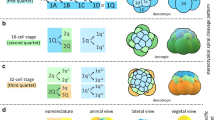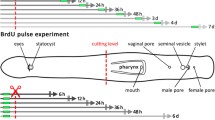Abstract.
We have analyzed the embryonic development of the temnocephalid flatworms Craspedella pedum and Diceratocephala boschmai, using a combination of fuchsin-labeled whole-mount preparation, histology, and transmission electron microscopy. Following the staging system recently introduced for another flatworm species (Mesostoma lingua), we can distinguish eight morphologically defined stages. Temnocephalids produce eggs of the neoophoran type in which a small oocyte is surrounded by a layer of yolk cells. Cleavage takes place in the center of the yolk mass (stages 1–2) and results in an irregular, multilayered disc of mesenchymal cells that moves to the future ventral egg pole (stage 3). Organ primordia, including those of the brain, pharynx, male genital apparatus, sucker, and epidermis "crystallize" within this disc without undergoing gastrulation movements (stage 4). An invagination of the epidermal primordium pushes the embryo back into the center of the yolk ("embryonic invagination"). As a result, organogenesis begins while the embryo is invaginated (stage 5). The brain differentiates into an outer cortex of cell bodies that surround a central neuropile. Precursor cells of the epidermis, pharynx, and protonephridia become organized into epithelia. During stage 6, the embryonic primordium everts back to the surface, where organogenesis and cell differentiation continues. Epidermal cells fuse into a syncytium that expands around the yolk. Myoblasts initially do not spread out in the way epidermal cells do; they remain concentrated in two narrow, longitudinal bands that extend along the sides of the embryo. Three pairs of axon tracts extending posteriorly from the brain follow the bands of myoblasts. Stages 7 and 8 are characterized by the appearance of eye pigmentation, brain condensation, and the formation of tentacles and a sucker that bud out from the epidermis of the anterior and posterior end, respectively. Comparison of morphogenesis in temnocephalids with observations in other flatworm taxa suggests a phylotypic stage for this phylum of invertebrates.
Similar content being viewed by others
Author information
Authors and Affiliations
Additional information
Electronic Publication
Rights and permissions
About this article
Cite this article
Younossi-Hartenstein, A., Hartenstein, V. The embryonic development of the temnocephalid flatworms Craspedella pedum and Diceratocephala boschmai . Cell Tissue Res 304, 295–310 (2001). https://doi.org/10.1007/s004410100376
Received:
Accepted:
Issue Date:
DOI: https://doi.org/10.1007/s004410100376




